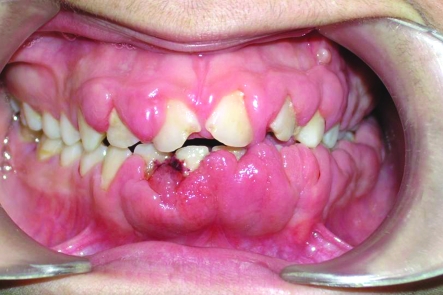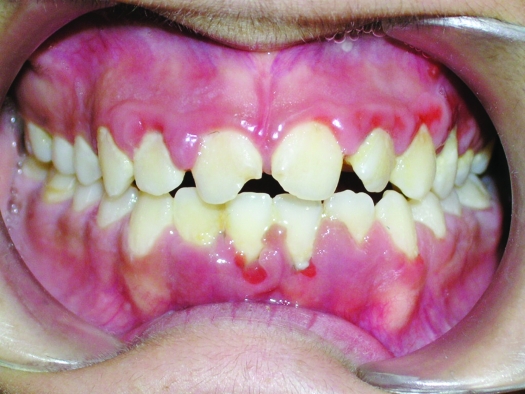Abstract
Acute Myeloblastic Leukemia (AML) is a malignant disease of bone marrow. Due to its high morbidity rate, early diagnosis and appropriate medical therapy is essential. Rapidly forming gingival hyperplasia is usually the first sign of this disease. This case report describes a 17-year-old female who presented rapid gingival overgrowth together with gingival bleeding in only two weeks time. A medical consultation was asked from hematology clinics and after a detailed medical examination Acute Monocytic Leukemia (FAB M5) was rendered. Chemotherapy was the choice of treatment. The patient responded well to chemotherapeutic induction regimen and after two months of medical therapy disease remised and gingival hyperplasia regressed. This case report shows that the gingival hyperplasia may represent an initial manifestation of an underlying systemic disease. Also, early medical therapy in acute monocytic leukemia may resolve the gingival hyperplasia that companies the disease progression.
Keywords: Acute monocytic leukemia, Gingival hyperplasia
INTRODUCTION
Leukemia is a hematological disorder which is caused by proliferating white blood cell-forming tissues resulting in a marked increase in circulating immature or abnormal white blood cells. Leukemia arises from a hematopoitetic stem cell characterized by a disordered differentiation and proliferation of neoplastic cells.1,2 Leukemia is characterized into acute or chronic forms, according to its clinical behavior, and characterized as lymphocytic and myelocytic, according to its histogenetic origin. Acute myeloblastic leukemia (AML), which is also known as; acute myelocytic leukemia, acute granulocytic leukemia or acute nonlymphocytic leukemia, is commonly classified under 8 subgroups according to the French-American-British (FAB) classification system. However in 1997, the World Health Organization proposed 4 groups in the AML category.2–5 Patient with AML generally present with symptoms related to complications of pancytopenia (anemia, neutropenia, and thrombocytopenia), including weakness, and easy fatigue, infections of variable severity, and/or hemorrhagic findings such as gingival bleeding, ecchymoses, epistaxis, or menorrhagia. Combinations of these symptoms are also common.1–3
Gingival overgrowth is defined as the excessive overgrowth of the gingival tissue. Gingival overgrowth has several causes, including poor oral hygiene, medications, serious systemic illnesses, hematological disorders, genetic conditions and it even can be idiopathic.6–10 Oral manifestation in patient with leukemia have been described in all subtypes of AML, chronic myeloid leukemia, acute lymphocytic leukemia, and chronic lymphocytic leukemia.7 Gingival infiltration represents a 5% frequency as the initial presenting complication of AML.4,5 Gingival infiltration of leukemic cells is most commonly seen in acute monocytic leukemia (M5) and acute myelomonocytic leukemia (M4).11,12 Dreizen et al13 evaluated 1076 leukemic patients and found gingival involvement in 66.7% of M5 patients and 18.5% of M4 patients.8,11,13–17
This report defines an AML patient with rapid gingival hyperplasia. The dentist was the first medical examiner who diagnosed the disease, referred her to hematology clinics, and after a successful chemotherapy patient’s gingival hyperplasia relapsed together with the remission of the disease.
CASE REPORT
A 17-year-old Caucasian woman applied to Cumhuriyet University, Faculty of Dentistry, Periodontology Clinic with the chief complaint of severe gingival hyperplasia with rapid development in two weeks time. Dental examination showed a prominent gingival hyperplasia, in both jaws, especially in the anterior region. Gingival hyperplasia was involving the buccal, lingual and palatal aspects, as well. The gingival was bulbous, pale and lacked stippling with local erythematic areas (Figure 1). Bone loss was not evident in panoramic radiograph. The dentist avoided from using periodontal probe and any periodontal treatment due to the unusual patient history. In the same day, the patient referred to Cumhuriyet University, Faculty of Medicine, Hematology Clinic with the preliminary diagnosis of leukemia. In medical examination, she suffered from systemic manifestations such as fatigue, nausea, vomit, anorexia, and weight loss in a month. Complete blood count, peripheral blood smear and bone marrow biopsy were taken from the patient. Complete blood count displayed a decrease in red blood cells with lowered hematocrit and hemoglobin levels (anemia); and a low platelet count (thrombocytopenia), although white blood cell levels were in normal values, a decrease in neutrophil levels (neutropenia) (Table 1). Bone marrow biopsy demonstrated 80% hypercellularity, predominated by monoblast cells. Peripheral blood smear revealed 52% mostly blast cells. Hematology clinic diagnosed the case as AML M5 according to peripheral blood smear and bone marrow biopsy in the several days. After the diagnosis of AML M5, The patient was only advised brushing her teeth, during the chemotherapy.
Figure 1.
Initial intra-oral view of the patient. Enlargement, especially in the frontal area is prominent. Enlargement widens through left side, both in maxilla and mandibula, without effecting the side right much.
Table 1.
Hematological findings of the patient, before and eight weeks after the initiation of chemotherapy. WBC: white blood cells; RBC: red blood cells; HGB: hemoglobin; HCT: hematocrit; PLT: platelets; NEUT: neutrophil.
| Initial | Eight weeks after | Normal | |
|---|---|---|---|
| WBC | 8.72 | 3.94 | 4–11 x 103 mm3 |
| RBC | 2.58 | 4.37 | 4.2–5.4 x 106 mm3 |
| HGB | 7.8 | 12.7 | 12–16 g/dl |
| HCT | 22.4 | 35.5 | 37–47 % |
| PLT | 94 | 269 | 150–400 x 103 mm3 |
| NEUT | 0.65 | 0.67 | 1.9–8 x 103 mm3 |
Medical Therapy
The patient was given chemotherapy consisting of intravenous administration of cytosine arabinoside (ARA-C, 100 mg/m2/day (200 mg) x 7 days) and idarubicin hydrochloride (idamycin, 12 mg/m2/ day (12 mg) x 3 days).
Eight weeks following the initial therapy, complete blood count values indicated remission (Table 1). Regression of the gingival hyperplasia without performing periodontal therapy was also prominent (Figure 2). One month later following initial therapy, monoblast cells were decreased from 80% to 5%. The patient was taken into maintenance therapy after initial therapy two times for two month. The medical administration was included; Cytosine arabinoside (ARA-C, 100 mg/m2/ day (200 mg) x 5 days) and idarubicin hydrochloride (idamycin, 12 mg/m2/ day (12 mg) x 3 days). Finally, the patient was transferred to a special center for bone marrow transplantation. Although we had recalled the patient after chemotherapy for periodontal therapy, the patient did not come to our clinic. Therefore, we could not have the patient’s outcomes.
Figure 2.
Healing of gingival hyperplasia at the eight week of chemotherapy. No periodontal therapy was performed during this period. Only meticulous oral hygiene was advised.
DISCUSSION
Even there are several etiologies for gingival overgrowth; usually each etiology has its own overgrowth characteristics. For example, while genetically induced gingival overgrowth show firm, normal coloured (pink), non-inflamed gingival tissues, gingival overgrowth due to blood dyscrasias are edematous, soft, tender to touch and show tendency to bleed.4,5,9,10,18
Gingival hyperplasia is most commonly seen with the AML subtypes acute monocytic leukemia (M5) (66.7%), acute myelomonocytic leukemia (M4) (18.5%), and acute myelocytic leukemia (M1, M2) (3.7%).19 In this case report, a rapid gingival hyperplasia together with gingival bleeding was the main reason of the patient to seek therapy. The dentist who examined the patient suspected from the duration of the overgrowth, and from the spontaneous gingival bleeding, without a prominent microbial dental plaque or calculus accumulation. A systemic disease such as probably one of the hematologic diseases was the dentist’s early diagnosis, and a hematology consultation was asked. Gingival involvement is common in AML and found in 66.7% of the 1076 leukemic M5 patients, in a study by Dreizen et al.13 In these kinds of patients, a dental therapy driven without hematological consultation could be fatal. The fact that gingival hyperplasia are sometimes the first manifestation of the disease implies that dental professionals must be sufficiently familiarized with the clinical manifestations of systemic diseases.6,8,11
Also a prominent remission was observed in gingival hyperplasia after chemotherapy together with peripheral blood values. This shows that, in cases like AML, elimination of the factor initiating the gingival hyperplasia or maintaining the ideal systemic condition might give a full success in periodontal healing. In this case, our patient’s medical condition forced us to do the medical therapy first, because of that the dental therapy of the patients was delayed to see the effect of medical therapy.
Microbial dental plaque increases this gingival hyperplasia induced systemic diseases. So, for totally remission of gingival hyperplasia, necessary periodontal therapy must be applied after systemic status was controlled by chemotherapy.
CONCLUSIONS
As a result, this case reminds that dentists and physicians should be aware of the importance of recognizing oral manifestations of systemic diseases. Although physicians most commonly diagnose leukemia, dentists can also diagnose patients with acute myelogenous leukemia. The dental practitioner should have an awareness of diagnostic signs and complications associated with leukemia to better aid in diagnosis and subsequent treatment and management. Medical consultation must be essential in dental therapy in such cases. This case also shows that gingival overgrowth due to acute leukemia is commonly improves by chemotherapy without any periodontal treatment.
ACKNOWLEDGEMENTS
I would like to thank Drs. Ulvi Kahraman GUR-SOY and Ebru OLGUN ERDEMIR for their assistance in this manuscript.
REFERENCES
- 1.Orbak R, Orbak Z. Oral condition of patients with leukemia and lymphoma. J Nihon Univ Sch Dent. 1997;39:67–70. doi: 10.2334/josnusd1959.39.67. [DOI] [PubMed] [Google Scholar]
- 2.Schiffer CA. Clinical features, diagnosis, and classifications of acute myeloid leukemia. http://patients.uptodate.com/topic.asp?file=leukemia/15783.
- 3.Barrett AP. Gingival lesions in leukemia. A classification. J Periodontol. 1984;55:585–588. doi: 10.1902/jop.1984.55.10.585. [DOI] [PubMed] [Google Scholar]
- 4.Williams WJ, Beutler E, Erslev AJ, Lichtman MA. Hematology. 4. New York: McGraw Hill; 1990. pp. 243–244. [Google Scholar]
- 5.Wu J, Fantasia JE, Kaplan R. Oral manifestations of acute myelomonocytic leukemia: a case report and review of the classification of leukemias. J Periodontol. 2002;73:664–668. doi: 10.1902/jop.2002.73.6.664. [DOI] [PubMed] [Google Scholar]
- 6.Anil S, Smaranayake LP, Nair RG, Beena VT. Gingival enlargement as a diagnostic indicator in leukaemia. Case report. Aust Dent J. 1996;41:235–237. doi: 10.1111/j.1834-7819.1996.tb04865.x. [DOI] [PubMed] [Google Scholar]
- 7.Bergmann OJ, Philipsen HP, Ellegaard J. Isolated gingival relapse in acute myeloid leukaemia. Eur J Hematol. 1988;40:473–476. doi: 10.1111/j.1600-0609.1988.tb00858.x. [DOI] [PubMed] [Google Scholar]
- 8.Hou GL, Tsai CC. Primary gingival enlargement as a diagnostic indicator in acute myelomonocyticleukemia. A case report. J Periodontol. 1988;59:852–855. doi: 10.1902/jop.1988.59.12.852. [DOI] [PubMed] [Google Scholar]
- 9.Long RG, Hlousek L, Doyle JL. Oral manifestations of systemic diseases. Mt Sinai J Med. 1998;65:309–315. [PubMed] [Google Scholar]
- 10.Parameter on periodontitis associated with systemic conditions. American Academy of Periodontology. J Periodontol. 2000;71:876–879. doi: 10.1902/jop.2000.71.5-S.876. [DOI] [PubMed] [Google Scholar]
- 11.Felix DE, Lukens J. Oral symptoms as a chief sign of acute monoblastic leukemia: report of case. J Am Dent Assoc. 1986;113:899–900. doi: 10.14219/jada.archive.1986.0308. [DOI] [PubMed] [Google Scholar]
- 12.McKenna SJ. Leukemia. Oral Surg Oral Med Oral Pathol Oral Radiol Endol. 2000;89:137–139. doi: 10.1067/moe.2000.102386. [DOI] [PubMed] [Google Scholar]
- 13.Dreizen S, McCredie KB, Keating MJ, Luna MA. Malignant gingival and skin “infiltrates” in adult leukemia. Oral Surg Oral Med Oral Pathol. 1983;55:572–579. doi: 10.1016/0030-4220(83)90373-0. [DOI] [PubMed] [Google Scholar]
- 14.Brenneise CV, Mattson JS, Commers JR. Acute myelomonocytic leukemia with oral manifestations: report of case. J Am Dent Assoc. 1988;117:835–837. doi: 10.14219/jada.archive.1988.0125. [DOI] [PubMed] [Google Scholar]
- 15.Epstein JB, Priddy RW, Sparling T, Wadsworth L. Oral manifestations in myelodysplastic syndrome. Review of the literature and report of a case. Oral Surg Oral Med Oral Pathol. 1986;61:466–470. doi: 10.1016/0030-4220(86)90389-0. [DOI] [PubMed] [Google Scholar]
- 16.Khera P, Zirwas MJ, English JC., 3rd Diffuse gingival enlargement. J Am Acad Dermatol. 2005;52:491–499. doi: 10.1016/j.jaad.2004.09.035. [DOI] [PubMed] [Google Scholar]
- 17.Pogrel MA. Acute leukemia. An atypical case presenting with gingival manifestations. Int J Oral Surg. 1978;7:119–122. doi: 10.1016/s0300-9785(78)80057-x. [DOI] [PubMed] [Google Scholar]
- 18.Kinane DF. Periodontitis modified by systemic factors. Ann Periodontol. 1999;4:54–64. doi: 10.1902/annals.1999.4.1.54. [DOI] [PubMed] [Google Scholar]
- 19.Cooper CL, Loewen R, Shore T. Gingival hyperplasia complicating acute myelomonocytic leukemia. J Can Dent Assoc. 2000;66:78–79. [PubMed] [Google Scholar]




